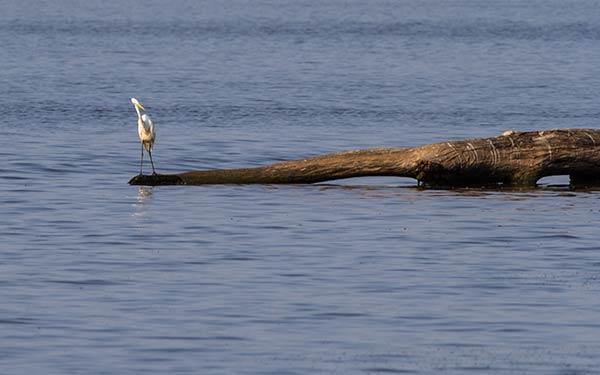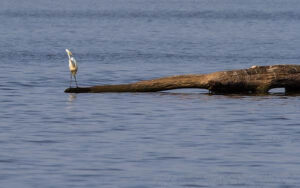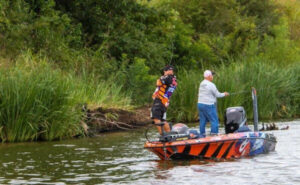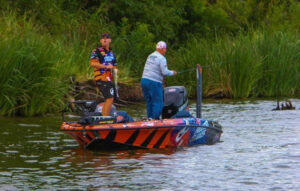In recent articles, we’ve been talking a lot about bass fishing shallow cover, and for good reason. Throughout this time of year, deep water oxygen levels deplete in many fisheries around the country, prompting big bass to head towards shallow water. Although it may be tempting to force an offshore bite in the heat of the summer, fishing shallow wood gives you a great chance of increasing both the quantity and quality of your catch in the late summer.
FLW Tour pro Dave Lefebre has spent countless hours perfecting his shallow wood fishing skills. As a youngster, he would routinely spend 12 hours each day continuously flipping and pitching to the same laydown in order to improve his presentation. Simply put, the man knows a thing or two about shallow wood and he has developed some simple tips that can help you catch more bass.
Characteristics to look for
To some folks, all fallen trees look the same. To Lefebre, however, there are some very subtle characteristics that make some laydowns better than others.
“When I’m looking for a great laydown to fish, I really like to find one that runs perpendicular to the shoreline,” Lefebre said. “This provides bass with several different opportunities. They can position on the shallow end of the laydown, right off the first break line from shore or they can even suspend under the laydown if it’s long enough to protrude into a nearby channel swing. The possibilities are endless.”
If you’re a regular on your home lake, you’ve more than likely seen dozens of anglers flock to newly fallen trees. Sure, it’s a new place to fish that’s likely to hold bass, but Lefebre likes to give laydowns some time to mature in the water.
“I’ve definitely caught some nice bass off of new laydowns, but I have more consistent success on old, dead ones,” Lefebre said. “When a tree or a big branch first falls into the water, it’s very easy to see because it’s usually covered with leaves and hasn’t settled into the water yet. These new laydowns will be more visible to other anglers, resulting in a big increase in fishing pressure.”
As a laydown sits in the water for an extended period of time, big bass have more time to find the laydown. The wood will also eventually rot, causing an increase in plankton and algae growth, which attracts a primary food source for bass.
“The longer a tree sits in the water, the more algae will grow on it,” Lefebre said. “Eventually, the presence of the algae will attract more shad, and big bass are never far behind. Not to mention, some laydowns will break off at the trunk after a few years, making the ‘meat’ of it much harder for some anglers to locate. For the observant angler, this is always a really good thing.”
Targeting resident fish
This time of year, anglers have the unique opportunity to target two different types of bass—newly displaced fish or shallow, resident fish. Lefebre believes laydowns located near deep water are most productive in the post-spawn period throughout the late spring, so he opts for a different, more laborious approach.
“I love targeting laydowns in the very backs of creeks during the late summer,” Lefebre said. “These areas play host to resident fish, which are bass that live there the entire year. They take a long time to replenish, but you can catch some absolute giants on these shallow laydowns.”
Lefebre also favors targeting resident fish in the late summer because they remain largely unmolested. As other anglers fish deep structure, he locates hard-to-access shallow backwaters when the water temperatures are in the 85 to 90-degree range.
“When you’re idling into these backwaters and you start wondering if you should turn around, that’s when you know to keep going,” Lefebre said. “It may be more difficult and take more time, but these resident fish don’t see nearly as many baits as main lake bass do.”
Accurate, quiet casts make all the difference
If you’re covering water with reaction baits when searching for a solid pattern, a poorly placed cast isn’t the end of the world. When fishing shallow laydowns, however, a single bad cast can make an enormous impact on your fishing day.
“A quiet bait entry is absolutely vital if you want to be a good laydown angler,” Lefebre said. “I always try to land on something, such as a limb, so I can slide my bait or lure into the water quietly. Catching two 5-pounders only takes two casts, and if you mess up on those casts, it can cost you the entire tournament.”
To become a more proficient caster, Lefebre suggests constructing a ‘casting course’ in your yard, or even the park. While walking through the course, try to flip your bait into empty coffee cans or underneath bushes.
“I used to walk through the park as a kid and flip my baits underneath playground slides and benches,” Lefebre said. “Everything is moving and you’re not elevated, so it makes it a lot easier when you finally get on the water. You might get some strange looks, but it works!”
Go light for more bites
For many of us, flipping thick laydowns calls for heavy duty braided line, or 20-pound fluorocarbon at the very least. Lefebre goes against this theory by using extremely small-diameter fluorocarbon.
“I avoid using braid in these situations because if you miss a fish, you’re all cinched up and stuck in the wood,” Lefebre said. “I use much lighter line than most folks do. Laydowns are the most pressured type of cover in almost any lake, so it’s not uncommon for me to use 10-pound Sufix Invisiline Castable Fluorocarbon to fool line shy bass. It’s really strong and I have a ton of confidence in it.”
Start on the outside and work your way in
Every angler approaches shallow laydowns differently, but Lefebre has a very precise way of dissecting them. Ever since he heard Roland Martin preach about it as a child, he begins on the outside.
“I don’t ever fish the meat of a laydown until I fish the edges,” Lefebre said. “In my opinion, it doesn’t make sense to flip to the very middle on your first cast. You want to see if the bass will come out and eat your bait on the edge first, so they’re easier to land. If you’re not getting bit on the outside, that’s when you need to start attacking the thick stuff.”
3 effective presentations for shallow laydowns
9/16-ounce jig – “A jig just gives you so much versatility on shallow laydowns,” Lefebre said. “You can swim it on cloudy days or just hop it along the bottom on sunny days with great results. I almost always use a trailer that has a great swimming action and lately I’ve been using a bluegill-colored Yamamoto Double Tail Grub on a brown or green jig. It’s very universal and catches a lot of big bass.Rapala Scatter Rap Crank or Rapala DT Fat 3 – “The scatter crank has really been key for me around laydowns,” Lefebre said. “It absolutely does not hang up it constantly bangs into every piece of wood, creating some great reaction bites. In dirtier water and around trees with fewer branches, I like the Rapala Fat 3 because it displaces a bunch of water with its very wide wobble.”3/8-ounce Terminator Spinnerbait – “In muddier water, I like to use a chartreuse and white skirt with turtle blades,” Lefebre said. “It’s heavy enough to have the velocity to cast underneath limbs and you can place it in small cracks and crannies very easily. It’s a great choice for fishing very gnarly wood.”
If it has been especially warm in your area this summer, fishing shallow laydowns is a great alternative when your offshore bite wanes. If you learn how to detect productive laydowns and how to approach them effectively, you’ll be able to salvage what’s left of this summer.















